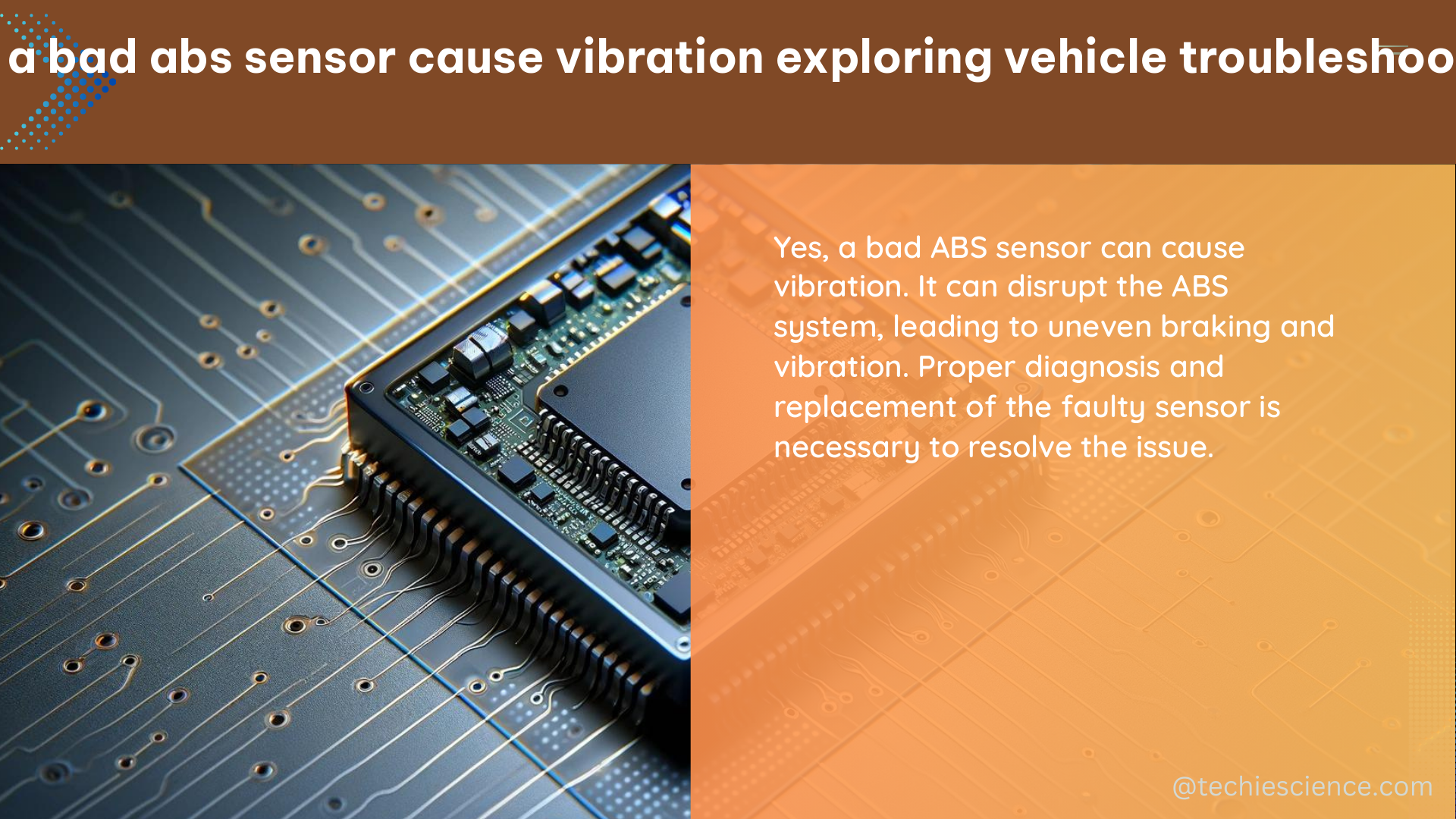A malfunctioning ABS (Anti-lock Braking System) sensor can indeed be a common culprit behind unwanted vibrations felt in the brake pedal or steering wheel during braking. This is because the ABS sensor is responsible for providing the ABS control module with accurate wheel speed data, which is crucial for the proper functioning of the braking system.
Understanding the Role of ABS Sensors
The ABS system in a vehicle is designed to prevent the wheels from locking up during heavy braking, which can lead to a loss of control and potentially dangerous situations. To achieve this, the ABS system relies on a network of speed sensors, typically one for each wheel, that constantly monitor the rotational speed of the wheels.
These sensors convert the wheel’s rotational speed into an electrical signal, which is then sent to the ABS control module. The control module uses this information to determine if a wheel is about to lock up, and it then adjusts the brake pressure accordingly to prevent the wheel from locking.
How a Bad ABS Sensor Can Cause Vibrations

When an ABS sensor is faulty or malfunctioning, it can send inaccurate speed signals to the ABS control module. This can cause the ABS system to engage unnecessarily, leading to a pulsing or vibrating sensation in the brake pedal or steering wheel.
Here are some of the ways a bad ABS sensor can contribute to vibrations:
-
Incorrect Speed Signals: If the ABS sensor is not accurately measuring the wheel’s rotational speed, the ABS control module may interpret this as a potential wheel lock-up, even when the brakes are functioning normally. This can trigger the ABS system to activate, resulting in the characteristic pulsing or vibrating sensation.
-
Uneven Brake Pad Wear: A faulty ABS sensor can cause the ABS system to engage unevenly, leading to uneven wear on the brake pads. This can create an imbalance in the braking forces, resulting in vibrations.
-
Intermittent Sensor Failure: An ABS sensor that intermittently fails or provides inconsistent signals can cause the ABS system to engage and disengage rapidly, leading to a noticeable vibration.
-
Sensor Misalignment: If an ABS sensor is not properly aligned with the wheel’s rotation, it can provide inaccurate speed signals, triggering the ABS system to respond inappropriately and causing vibrations.
Diagnosing a Bad ABS Sensor
To determine if a bad ABS sensor is the root cause of the vibrations, you can follow these diagnostic steps:
-
Visual Inspection: Carefully inspect the ABS sensors for any signs of damage, such as cracks, corrosion, or loose connections. Check the sensor wiring for any signs of wear or damage as well.
-
Voltage Testing: Use a multimeter to measure the voltage output of each ABS sensor. A healthy sensor should produce a voltage of around 1 volt AC at rest, and the voltage should increase as the wheel speed increases. If one sensor is not within this range, it may be faulty.
-
Sensor Unplugging Test: With the ABS system re-enabled, unplug each ABS sensor one at a time and observe if the vibration persists. If the vibration disappears when a specific sensor is unplugged, that sensor is likely the culprit.
-
Diagnostic Trouble Codes: Use an OBD-II (On-Board Diagnostics) scanner to check for any diagnostic trouble codes related to the ABS system. These codes can provide valuable information about the specific sensor or system that is malfunctioning.
-
Brake Pad Inspection: If the vibration persists even after testing the ABS sensors, inspect the brake pads for uneven wear, as this can also contribute to vibrations.
Addressing a Bad ABS Sensor
If a faulty ABS sensor is identified as the cause of the vibrations, the appropriate course of action is to replace the sensor. This typically involves the following steps:
-
Sensor Replacement: Locate the malfunctioning ABS sensor, disconnect it, and replace it with a new, compatible sensor. Ensure that the new sensor is properly aligned and secured.
-
Sensor Calibration: After replacing the sensor, the ABS system may need to be calibrated to ensure that the new sensor is properly integrated into the system. This may require the use of a diagnostic tool or specialized equipment.
-
System Reset: In some cases, resetting the ABS system by disconnecting the battery or using a diagnostic tool may be necessary to clear any stored diagnostic trouble codes and allow the system to relearn the new sensor.
-
Brake System Inspection: It’s also a good idea to inspect the entire brake system, including the brake pads, rotors, and calipers, to ensure that there are no other underlying issues that could be contributing to the vibrations.
Conclusion
In summary, a bad ABS sensor can indeed be a common cause of vibrations felt in the brake pedal or steering wheel during braking. By understanding the role of ABS sensors, diagnosing the issue, and addressing the problem through sensor replacement and system calibration, you can effectively resolve the vibration issue and ensure the safe and reliable operation of your vehicle’s braking system.
Reference:
– Thumping Sound and Vibration in Brake Paddle When Brakes
– ABS Speed Sensor Wheel Vibration
– How to Test ABS Sensors

The lambdageeks.com Core SME Team is a group of experienced subject matter experts from diverse scientific and technical fields including Physics, Chemistry, Technology,Electronics & Electrical Engineering, Automotive, Mechanical Engineering. Our team collaborates to create high-quality, well-researched articles on a wide range of science and technology topics for the lambdageeks.com website.
All Our Senior SME are having more than 7 Years of experience in the respective fields . They are either Working Industry Professionals or assocaited With different Universities. Refer Our Authors Page to get to know About our Core SMEs.